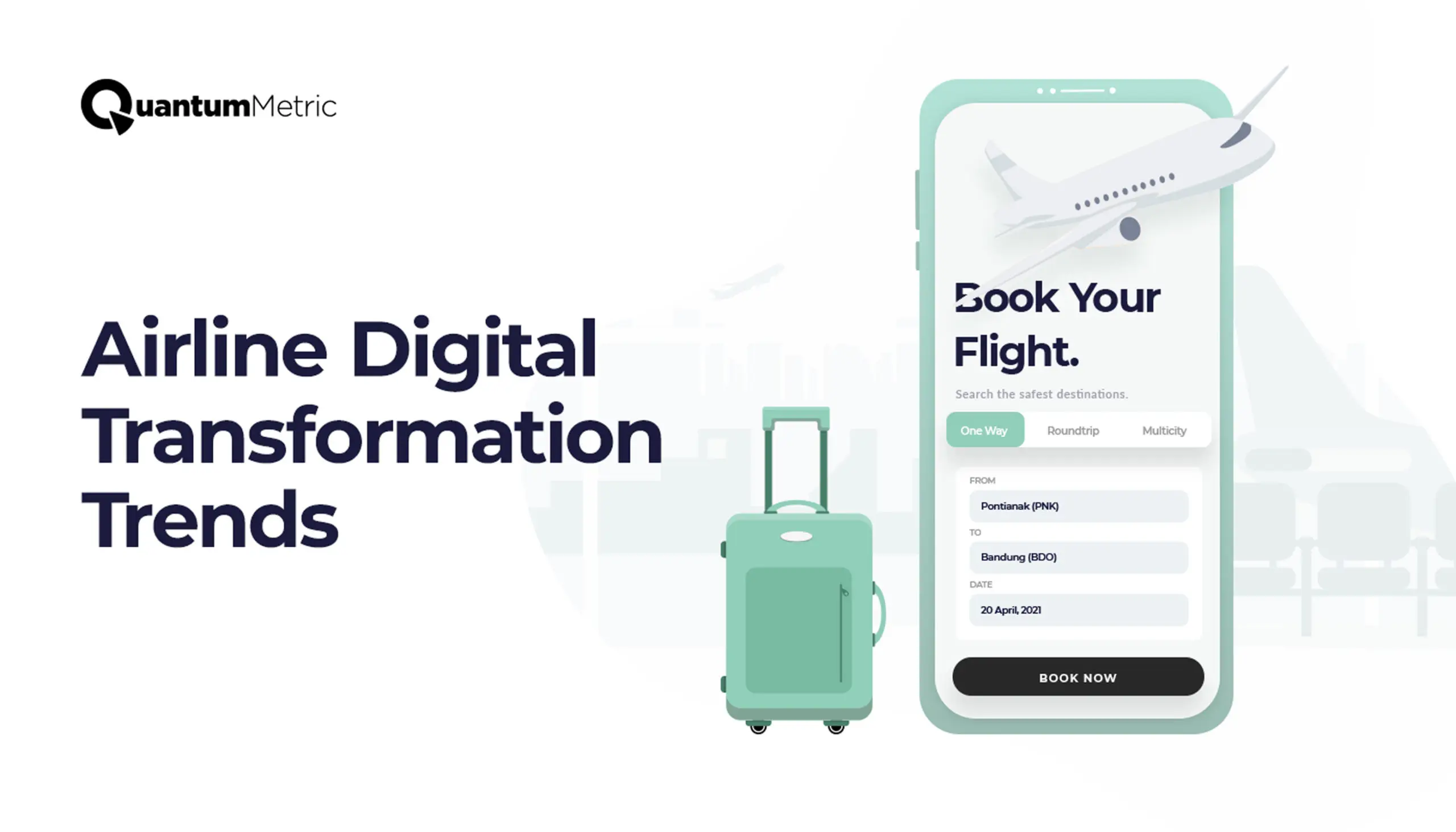Airline Digital Transformation Trends in 2021

While the digital economy is growing faster everyday for each industry, airlines are especially focused on digital transformation as they look to rebound from the losses they incurred from the pandemic, which virtually ground travel to a halt last year. Here’s a look at some key trends in airline digital transformation that are helping passengers get to their next destination as safely and efficiently as possible.
Acting faster with few resources
In 2020, travel restrictions caused U.S. airlines to hit the lowest level of employment in decades–around 90,000 jobs were slashed. Now that the CDC says that travel is low risk for fully vaccinated people, airlines will need to scale their operations quickly as more people resume traveling. In China, where the most recent Covid-19 wave has been contained, airline travel for the month of April 2021 has returned to pre-Covid levels, by some metrics.
Airline teams have shrunk. Travel recovery is varying dramatically across the globe due to uneven vaccine rollouts. Daily changes and rules in travel mean that bookings and available destinations shift almost daily, from one country or U.S. state to another. And that’s not to mention the changes that occur while customers are traveling, such as delays, gate changes, and cancellations. In fact, summer airline schedules are up in the air. Airlines are using “placeholder” schedules, which means that flights may be unexpectedly canceled or rescheduled, depending on demand. American Airlines has been adding flights within the US, Mexico, and the Caribbean in anticipation of a busy summer following the vaccine rollout.
For airlines, this means that acting fast is key. Data, whether from real-time insights or collected from larger customer segments over a longer period of time, supports agility.
Investing in airline digital transformation technology
But to act faster using customer data, teams will need better technology to advance their airline digital transformation agenda.
Some experts predict that digital innovation for airlines will improve productivity, open new revenue streams, and “generate an incremental value of $5-$10 for every passenger, annually.” In the post Covid-19 world, competition in the airline industry will be intense. To drive customer satisfaction and create sustainable business models, airlines will need to carefully choose their technology solution providers.
Internet of Things. Big Data Analytics. Artificial Intelligence. Machine Learning. Passenger data capture. Digital Call Centers. Business Intelligence.
Airline investments in these areas will drive corporate strategies, help create innovative business models, and transform the overall airline customer experience. In particular, airlines will double down on offering seamless omnichannel experiences, standout mobile app experiences, AR/VR, and e-commerce features to keep customers returning to mobile devices even after their trips end.
Leveraging digital passports
Digital Covid-19 vaccine passports might also become a common feature for airline travelers, especially for international trips.
People who receive their Covid-19 vaccinations at Walmart and Sam’s Club chain stores, for instance, can use mobile applications such as Health Pass and CommonPass to verify their vaccination records. Smartphones generate QR codes so that patients do not have to share sensitive information with airlines, such as where the user received a vaccination or Covid-19 test. The QR code simply clears travelers to board the plane.
JetBlue, Luftshansa, United, and other airlines have already started using CommonPass for international flights. According to The New York Times, “The app will then issue confirmation codes enabling passengers to board certain international flights. It is just the start of a push for digital Covid-19 credentials that could soon be embraced by employers, schools, summer camps and entertainment venues.”
Overcoming organizational silos
With smaller teams, airlines are realizing that stakeholders from across the organization–including IT, sales, marketing, and customer service–are becoming more interconnected than ever before. CIOs, CDOs, and CMOs are increasingly being called to weigh in on major investments in technology for digital airline transformation.
Smaller teams means that breaking down operational silos will become more important than ever. In the past, sales and marketing focused on segmenting audiences, reaching out to customers, and measuring impressions. IT teams, on the other hand, were primarily concerned with the payment workflow. This meant that they had little to no knowledge of what customers have previously encountered.
When data about customer intent or customer history is available to all teams, groups across the organization can measure the impact of product decisions by relating each backlog item to KPIs such as conversion rate and revenue. By focusing on these pain points, airlines can use data-driven design thinking to reduce user friction and drive customer satisfaction. Airlines need to use actual customer data to determine what passengers truly need from their digital experience. Product decisions should not be based on intuition, or what executives and product owners think customers need.
The bottom line? Airlines need to invest in technology that improves the customer and passenger experience, which, in turn, will enhance operational models and lead to profitability.
Providing contactless experiences for airline travelers and employees
Unlike other industries such as retail, the airline industry must approach digital innovation differently due to regulatory and safety concerns. According to an article from Wired, only recently have clipboards and paper been “replaced by cloud-based computer systems and tablets for a paperless future where important information can be transferred instantly and securely, minimizing unnecessary journeys and saving time for airport staff – and for passengers.” Finally, airline teams are “being equipped with tablets…which replac[e] paper-based systems with real-time cloud computing to eliminate human error and wasted time during refueling.”
In terms of digital airline transformation, Covid-19 has also prompted travelers to think more deeply about safety and sanitation. Some experts predict that, compared to before the pandemic, more Americans will wear masks, sanitize their hands, avoid large gatherings, and use mobile devices to avoid in-person contact when possible, such as when ordering a meal at the airport or checking in for a flight.
Doubling down on the digital omnichannel experience
While traditional customer journey mapping was in decline by 2019, the pandemic accelerated the shift to customer-led journeys for marketers. With airline passengers switching between channels and devices–including smartphones, tablets, desktops, and airport check-in kiosks–all digital components need to work together seamlessly to ensure that passengers can book and manage their travel without a hitch.
Breeze Airways, which is branding itself as half tech startup, half airline, is building a complex mobile application, offering cutting edge self-service kiosks for check-ins, streaming on personal devices, and more. According to an article from Business Insider, “Customers will be able to handle pretty much every part of their flight through an app, plus a website and possibly kiosks at the airport, from purchasing tickets, accessing boarding passes, registering checked bags changing flights, trading seats, and more. Each of those steps removes the need to interact with a person.”
Other airlines such as Alaska Airlines have noticed these trends and have beefed up in-flight entertainment experience by investing heavily in mobile app experiences, especially for frequent travelers. It turns out that the seat back entertainment systems that we all know and love weigh down planes, are expensive to operate, and cost approximately $10,000 per seat for installation. If you haven’t seen a seat back entertainment system in a while, it’s because airlines finally realized they weren’t sustainable for business.
Breeze, which plans to launch in 2021, is betting on delivering a standout mobile app experience to cut down on unnecessary and expensive customer service calls. Part of the airline’s business model is offering a mobile app experience that is in league with top e-commerce and social media apps, such as Amazon and Twitter.
How Quantum Metric his help with airline digital transformation?
The good news? Most airlines in the United States don’t need to build their tech stack from scratch.
The not-so-good news? Many airlines are still using outdated or siloed technology systems, making it difficult for organizations to act with agility and engage in digital transformation.
So how can airlines act with more agility?
For starters, they should start iterating on, and thus improving, what they already have.
Quantum Metric, the Continuous Product Design Platform, can help airlines determine which errors, bugs, design problems, and other backlog items have the largest impact on the business’s bottom line.
Teams across an airline–including product, engineering, support, call center, and design–can leverage Quantum Metric to reduce call center times, reduce helpdesk time, reduce engineering time on defect resolution, and even improve the employee experience.
Here’s a look at just some of the few ways Quantum Metric is helping airlines act with more agility.
Reduce call center time
Instead of asking the customer to explain in detail where they struggled on the airline’s website, an agent can simply ask the user when he/she visited the site, look up the user’s session in Quantum Metric with a user attribute (like a mileage or ticket number), and then watch the replay to troubleshoot the issue.
Reduce helpdesk time
When frontline agents identify a problem, they open a helpdesk ticket with a link to the replay queued up to the exact point of friction in the user session. Airlines partnering with Quantum Metric have also begun training agents to include the number of guests impacted by the same friction, which can be done easily with the platform’s “see more like this” functionality.
Reduce engineering time on defect resolution
When the issue lands with the engineering team, teams no longer have to figure out how to reproduce the problem. Engineers open the ticket, with a link to the replay and can quickly work through a defect and see all the API calls and other technical details.
Improve the employee experience
Some airlines, including Alaska Airlines, also use Quantum Metric on an internal customer service agent (CSA) app. The Continuous Product Design platform gives the app team visibility into where its associates struggle most, almost eliminating the need to observeCSAs working in local airports.
Enhance seat maps and upselling opportunities
Passengers use mobile applications to change their seats, purchase additional luggage, or upgrade from economy to first class. With Quantum Metric, digital teams can optimize the passenger experience so that airlines aren’t leaving any money on the table while upselling.









